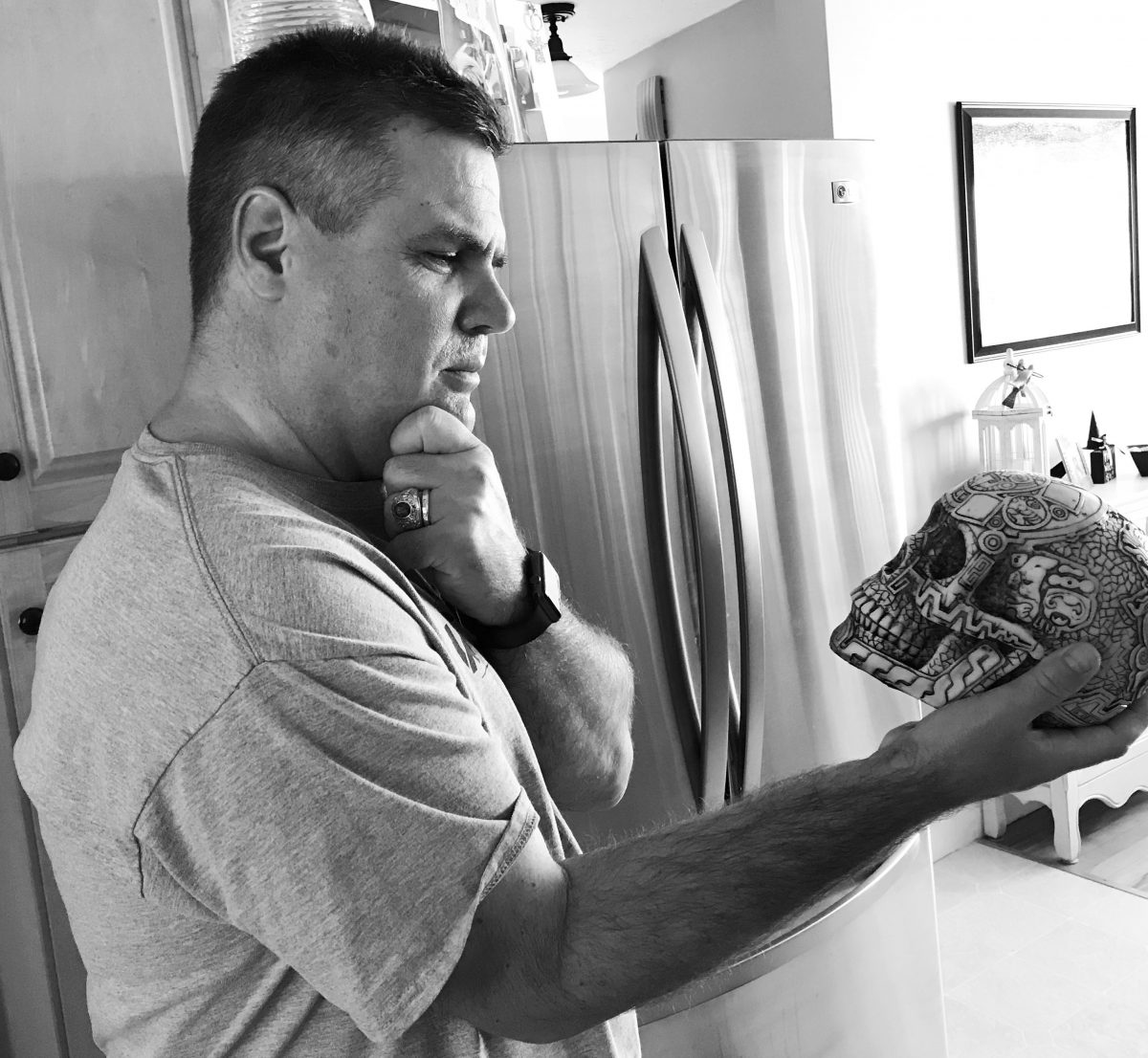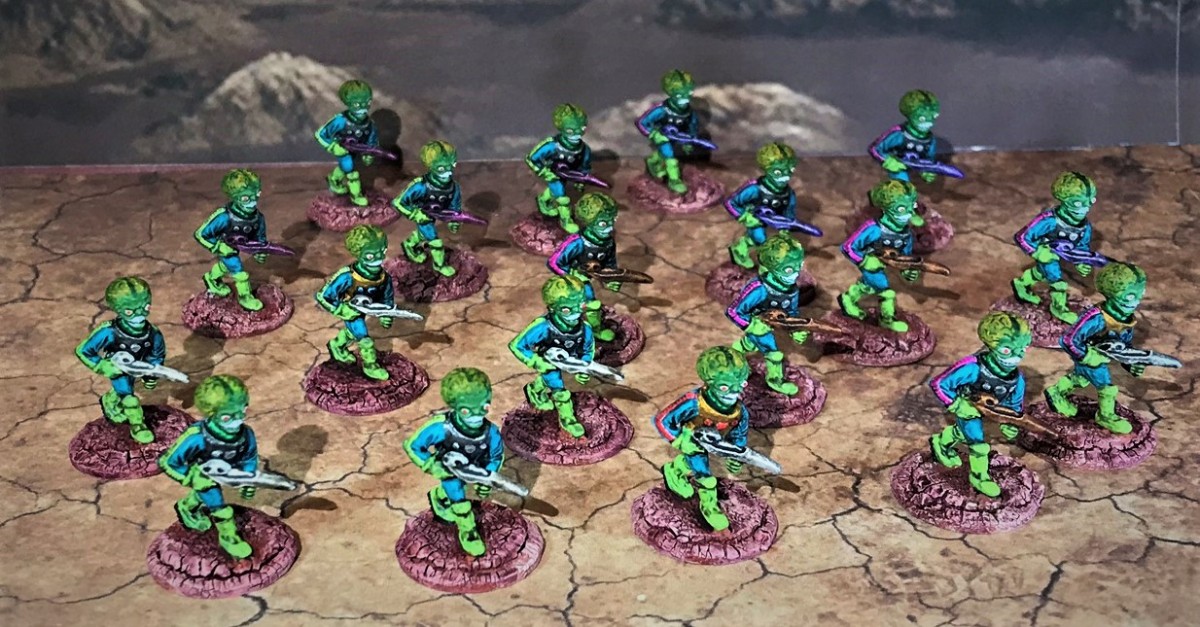For August, I decided that my efforts needed to be directed towards a few new areas that would be challenging for me. I wanted to get more terrain for my games, specifically some that would be useful in making my Combat Patrol™ games more visually appealing to the players. I also wanted to try to use some new techniques and incorporate new materials into my hobby kit bag.
This would involve working on things and using multiple materials with which I am less than fully experienced. My goal was to stretch my horizons as it were, and this goal also dovetailed nicely with the monthly painting challenge run by our Australian friend Azazel. The theme for August was “Technical August”, which was a wide-open challenge to try or improve upon techniques that we had little to no experience in doing previously. With that said, I decided that assembling, building, and painting some Armorcast terrain would be a good way to do that. Mainly my goal was to focus on using the five 4-pigment bottle sets of Vallejo Pigments that I have not really used (Dust & Dirt, Mud & Sand, Rust & Corrosion, Soot & Ashes, and Stone & Cement). I did use the Soot & Ashes set on some cheap 3D printed buildings, but otherwise not much.
I acquired three types of Armorcast resin terrain (all suitable for 28mm scale) for the August challenge – craters, ruined buildings, and sci-fi ruined walls:
- 1 ACCR001 3-crater set (includes 3 differently-sized impact craters – 6″, 4″, and 3″ – and the set is the subject of this post)
- 5 ruined building corners (subjects of a future post)
- 6 sci-fi walls (subjects of a future post)
- 1 ACW007 High Tech Walls 2 (each set includes 2 walls)
- 2 High Tech Walls 1 (each set includes 2 walls)
As for my technical goals, my list of “challenge” skills, materials, and techniques include:
- Assembling, building, and basing terrain
- Use of materials to create weathering and rusting effects, to include:
- Vallejo Pigments, to include application and fixing (covered in this blog post)
- Vallejo Mecha Color weathering products
- Weathering and rusting/oxidizing effect products, to incude:
- Citadel Technical paints:
- Typhus Corrosion
- Ryza Rust
- Nihilakh Oxide
- Vallejo and Vallejo Mecha Color rusting and weathering products
- Vallejo Pigments (various)
- Vallejo Game Air rusts (71.069 and 71.080)
- Vallejo Mecha Color Weathering products
- Oil Stains (gloss)
- Rust Wash
- Rust Texture (Matt)
- Citadel Technical paints:
- Create a new storage system for my terrain pieces
The ones above in bold font are ones I worked on for the 3-crater project. Others will be used for the remaining projects, even if that lasts into September (which is likely).
I had previously worked on some Armorcast sci-fi pieces and grenade blasts. I like their products, but wanted to get better at getting them on the tabletop.

I got good advice from Armorcast (Gin Fritter) and Buck Surdu about preparing the resin for painting. I ended up using a few Exacto knives to remove flash, and then used Scotch-Brite pads to lightly (imperceptibly in fact) give the pieces a rubdown to achieve a “bite” for airbrush priming. Additionally, I used a 180 grit sandpaper sheet to scuff up the craters’ bottoms so that they would glue better to their planned bases. I then washed the pieces thoroughly with dish washing soap in the sink and let them dry.
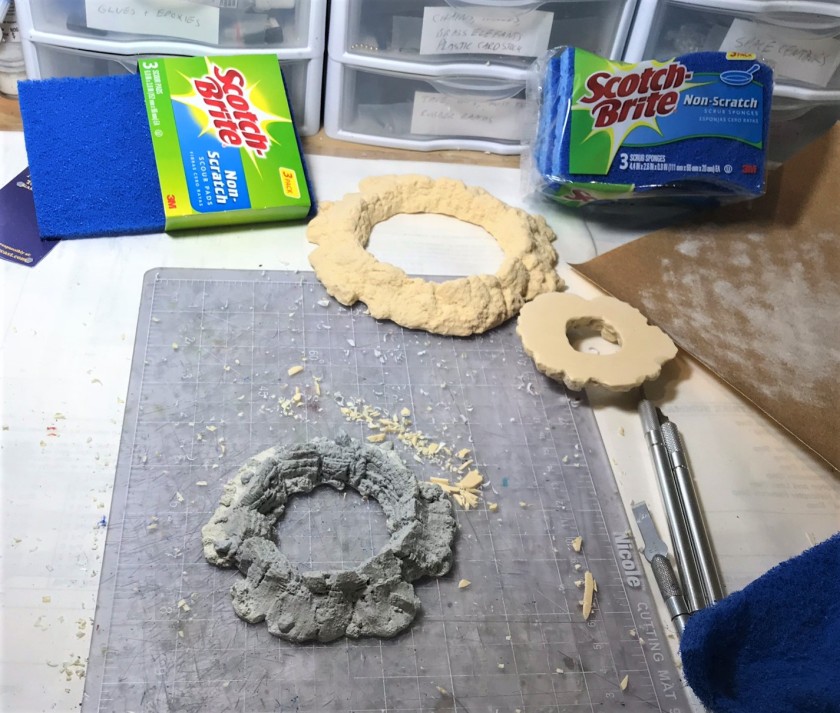
For basing, I chose to incorporate a few different materials. First, I cut irregular shapes from Evergreen Scale Models #9020 polystyrene sheets – which is quite thin (.020″/0.5 mm). I mounted the crater pieces to the cut shapes with Gorilla Glue. Then, I also used a number of differently sized thin steel bases from Wargames Accessories to mount under the shapes for both strength and to be able to later store and transport securely in magnetically lined storage boxes (which is another project in and of itself that I have planned). Here, I also used Gorilla Glue.
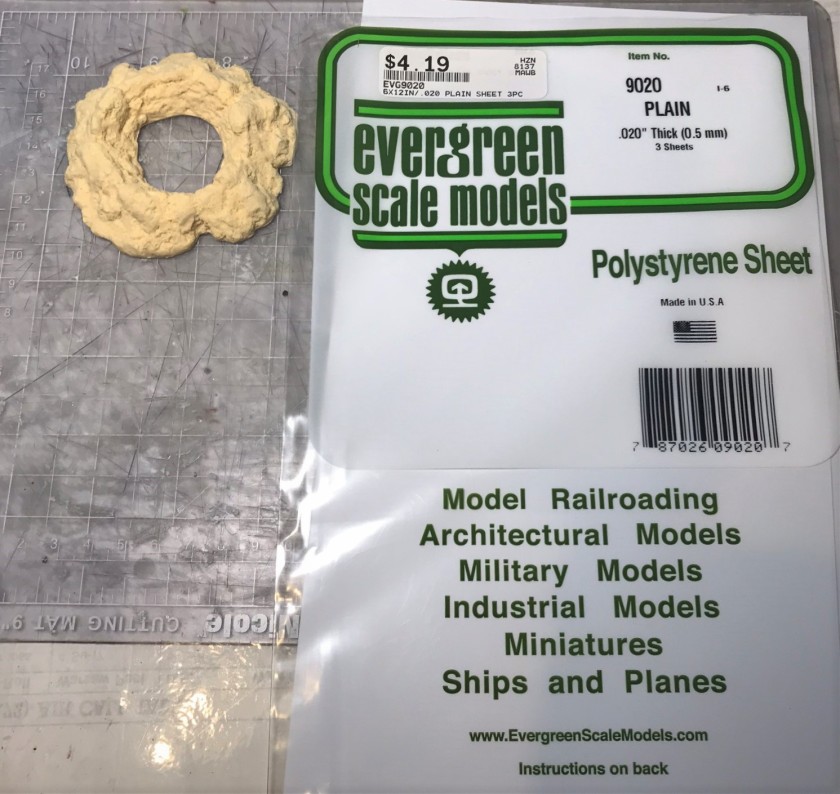
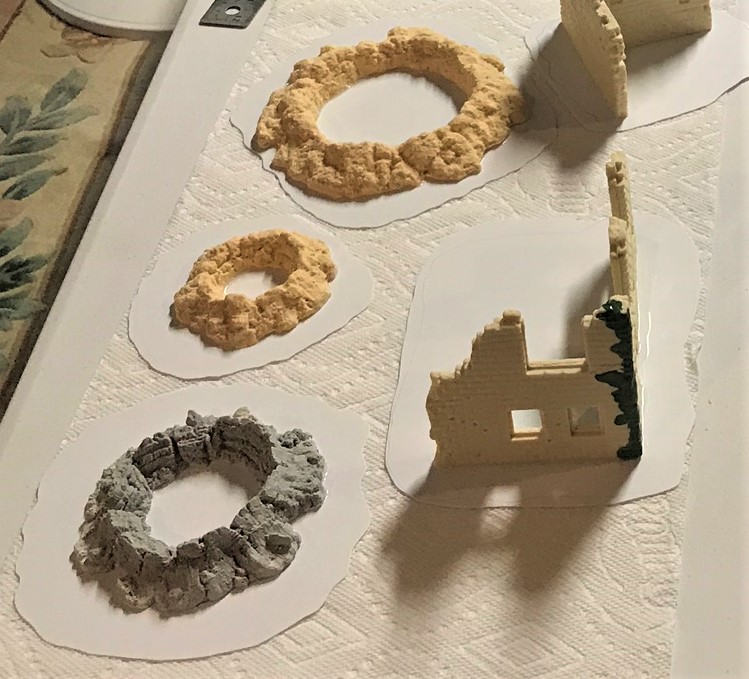
From my minimal experience with using pigments, I knew they had the potential for a huge mess. I learned that using a cafeteria-type tray would make using them easier. I hit my local Salvation Army and found four trays for this use. Interestingly, three of them were from a former Digital (DEC) facility (there were a lot of them in Massachusetts before Compaq and later Hewlett Packard consumed them in 1998). I removed what appeared to be ancient chili from them, and put them into use. I also got a small palette from Michael’s craft store to use just for pigments. I put that palette into a deep plastic Rubbermaid salad container, and I thereby effectively limited the migration of pigments from my work space. You definitely do not want to have a fan or strong air circulation going while using pigments!
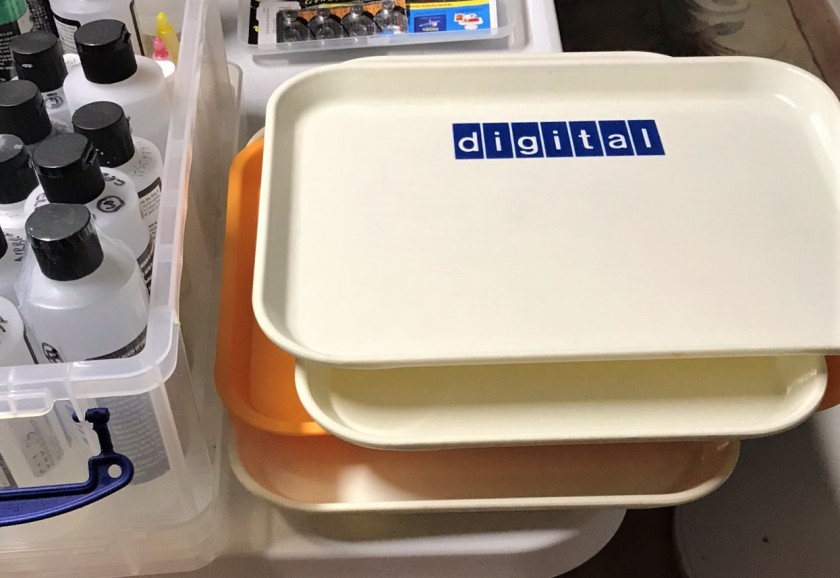
I then used PVA glue (good old Elmer’s) to affix some play sand and some Woodland Scenics stones to the bases, and let them harden.

Next, in order that I could handle and work with the craters, I affixed their bases with poster tack to upside-down plastic plates before priming. I marked each plate with a brown ink line for reference, and proceeded to airbrush prime the set with Vallejo “Surface Primer – Gray”.

I then worked on the three craters sequentially, going from smallest to largest. For the smallest one, I dry brushed with multiple shades of brown (there is a list of materials that I used at the end of this blog). I was not sure that I needed to or if the pigments would be enough. Primarily, I used the four pigments from the Vallejo “Mud and Sand” set (“Light Yellow Ochre”, “Natural Umber”, “Light Sienna”, and “Light Slate Grey”) plus the Vallejo “Faded Olive Green”. I looked at the Vallejo YouTube video on pigments, and used some of the different techniques to apply and fix the pigments.


After this, I moved on to the next larger crater, and also dry brushed it and used the same method of fixing the pigments. One downside that I discovered was that the airbrush thinner tended to dissolve the PVA holding the rocks in place (but not the sand). I replaced the displaced rocks on the bases after the airbrush thinner dried.

Lastly, I worked on the largest crater. Here, I passed on doing any dry brushing. For this one, I employed Vallejo “Pigment Binder” instead of the airbrush thinner to fix the pigments – and to prevent the dissolving issue under the added rocks. I also needed to use Secret Weapons Washes “Sewer Water” to give better shading. While the pigment binder worked, it did lead to a thicker application of pigment as you see below. I thought it blended too much – and I believe that one should use that product selectively. I subsequently added more pigments to make the crater less of a solid olive green, fixing them with airbrush thinner. It worked.

Lastly, I decided to airbrush varnish the craters. Did I need to? I wanted to protect the paint work, so I did. I do think I needed to thin the varnish more, as I had some crazing to deal with, something I had not seen previously with its use on miniatures. To help with color variety, I applied Citadel “Agrax Earthshade” and “Athonian Camoshade” washes, mixed with a little varnish and applied with a brush to the affected areas. I then applied Army Painter “Wasteland Tufts” and some 12 mm grasses from Shadow’s Edge Miniatures.
As an aside – I can say without a doubt that the Shadow’s Edge Miniatures products are far superior to Army Painter’s – they need no additional gluing, and they are visually stunning. I plan on using their products, especially the flowers, on future unit bases to help with tabletop differentiation.
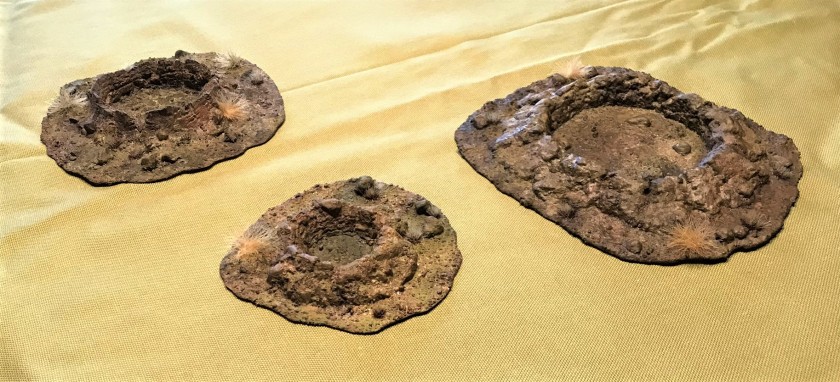



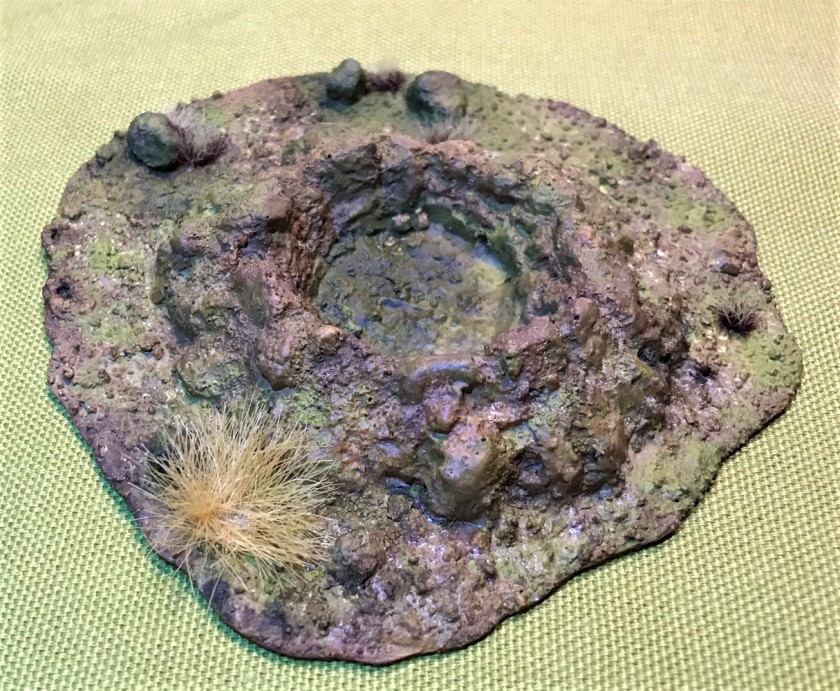



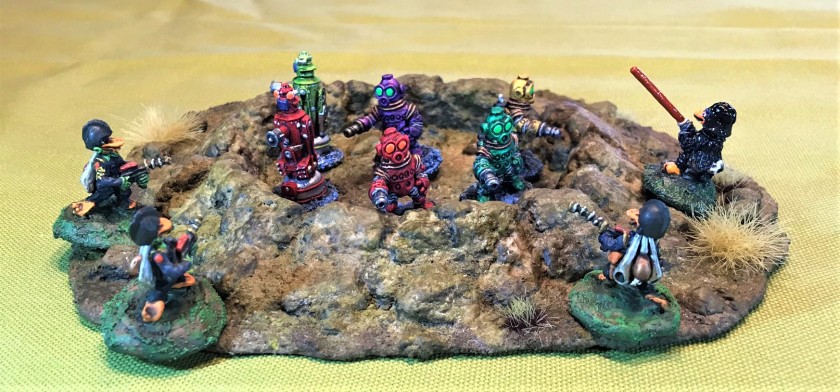
My lessons and thoughts from the project:
- The cleaning and scrubbing of the resin helped with the priming. The Scotch-Brite pads work well for this use.
- For terrain pieces that will be totally covered in pigments, dry brushing with paint is not needed. When I get to doing vehicles, such as tanks, it will be interesting to see how that works.
- Fixing pigments with airbrush thinner is easier than with pigment binder. However, add any additional large features, such as extra rocks later, or use pigment binder on the rocks.
- Having trays and palette wells (such as the one I put my palette in) while working with pigments cuts down on the mess considerably. Be ready to use multiple brushes, both wet and dry. The mess vacuumed up or washed off easily from my palettes and trays.
- Always ensure your pigment bottles are shut tight. I see how they could spill over easily (and I was lucky enough not to have this problem).
- PVA glue and play sand are an inexpensive winner.
- The combination of thin steel and thin polystyrene yields a model base with little to any “rise” from the tabletop at its edge, and is strong.
- Thin your varnish to prevent the crazing! (Speaking with Buck today, he uses varnish to fix his pigments, so that needs to be considered). I also want to see how well airbrushing the thinner fixes pigments in future projects, like my ruined buildings.
- Washes help in the end for touch ups.
- Shadow’s Edge Miniatures tufts are fantastic – need no extra glue and dry clearly.
Now the three craters are now ready to join my other terrain. Hopefully I can get more done this month.
Thanks for reading and if you have feedback, especially on my results or suggestions from your experiences, please, share them in the comments section. I do so much appreciate them!
PAINTS, PIGMENTS, INKS, GLUES, GLAZES, WASHES, AND FLOCKING USED:
- Vallejo “Surface Primer – Gray”
- Generic play sand
- Elmer’s “Glue-All”
- SceneARama “Rocks”
- Evergreen Scale Models #9020 0.5 mm plain polystyrene sheets
- Gorilla Glue
- Wargames Accessories steel bases (various)
- Americana “Raw Umber”
- Citadel “XV-88”
- American “Burnt Sienna”
- Citadel “Skrag Brown”
- Citadel “Balor Brown”
- Vallejo “Natural Umber” (pigment)
- Vallejo “Light Yellow Ochre” (pigment)
- Vallejo “Light Slate Grey” (pigment)
- Vallejo “Light Sienna” (pigment)
- Vallejo “Faded Olive Green” (pigment)
- Vallejo “Airbrush Thinner”
- Vallejo “Pigment Binder”
- Vallejo “Airbrush Flow Improver”
- Secret Weapons Washes “Sewer Water” (wash/shade)
- Citadel “Agrax Earthshade”
- Citadel “Athonian Camoshade”
- Testors “Universal Acrylic Thinner”
- Vallejo Mecha Varnish “Matt Varnish”
- Army Painter “Wasteland Tufts”
- Shadow’s Edge Miniatures “12 mm tufts”
Thanks again – I hope this helps you or please feel free to add your own suggestions in the comments section. After all, I am no expert in these – and I am just sharing my lessons learned – and I KNOW there are many other ways to accomplish what I did (I just don’t know them all!!).
